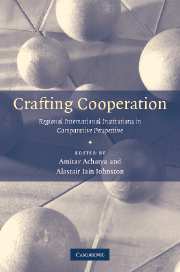Book contents
- Frontmatter
- Contents
- List of tables
- Notes on the contributors
- Acknowledgments
- 1 Comparing regional institutions: an introduction
- 2 Hanging together, institutional design, and cooperation in Southeast Asia: AFTA and the ARF
- 3 International cooperation in Latin America: the design of regional institutions by slow accretion
- 4 Crafting regional cooperation in Africa
- 5 Functional form, identity-driven cooperation: institutional designs and effects in post-Cold War NATO
- 6 Designed to fail or failure of design? The origins and legacy of the Arab League
- 7 Social mechanisms and regional cooperation: are Europe and the EU really all that different?
- 8 Conclusion: institutional features, cooperation effects, and the agenda for further research on comparative regionalism
- Bibliography
- Index
5 - Functional form, identity-driven cooperation: institutional designs and effects in post-Cold War NATO
Published online by Cambridge University Press: 22 September 2009
- Frontmatter
- Contents
- List of tables
- Notes on the contributors
- Acknowledgments
- 1 Comparing regional institutions: an introduction
- 2 Hanging together, institutional design, and cooperation in Southeast Asia: AFTA and the ARF
- 3 International cooperation in Latin America: the design of regional institutions by slow accretion
- 4 Crafting regional cooperation in Africa
- 5 Functional form, identity-driven cooperation: institutional designs and effects in post-Cold War NATO
- 6 Designed to fail or failure of design? The origins and legacy of the Arab League
- 7 Social mechanisms and regional cooperation: are Europe and the EU really all that different?
- 8 Conclusion: institutional features, cooperation effects, and the agenda for further research on comparative regionalism
- Bibliography
- Index
Summary
Introduction: new partners, new tasks
According to an oft-quoted aphorism of Lord Ismay, NATO's first Secretary-General, the purpose of the North Atlantic Alliance during the Cold War was “to keep the Americans in, the Russians out, and the Germans down.” In functional-institutionalist parlance, NATO as an international institution served to provide a high level of US and European military resources for the collective deterrence and defense of Western Europe against the Warsaw Pact, while making it hard for the US to defect in case of a Soviet attack and avoiding rivalries among the alliance members from resurfacing and escalating.
With the collapse of communism, the Soviet Union, and the Warsaw Pact, on the one hand, and the progress of European integration, on the other, the original purposes of NATO receded into the background. Instead, in a declaration agreed at NATO's London summit in July 1990, the alliance offered the Central and Eastern European transition countries to formally put an end to confrontation, establish permanent diplomatic relations with NATO, and base the future relationship on the principle of common security. In its Strategic Concept adopted in Rome in November 1991, NATO established a new, cooperative relationship with the countries of Central and Eastern Europe as an integral part of the Alliance strategy.
At the same time, NATO began to develop a set of new forums and frameworks to institutionalize this new relationship: NATO partnership.
- Type
- Chapter
- Information
- Crafting CooperationRegional International Institutions in Comparative Perspective, pp. 145 - 179Publisher: Cambridge University PressPrint publication year: 2007
- 1
- Cited by



